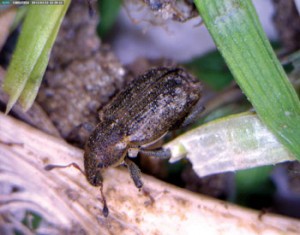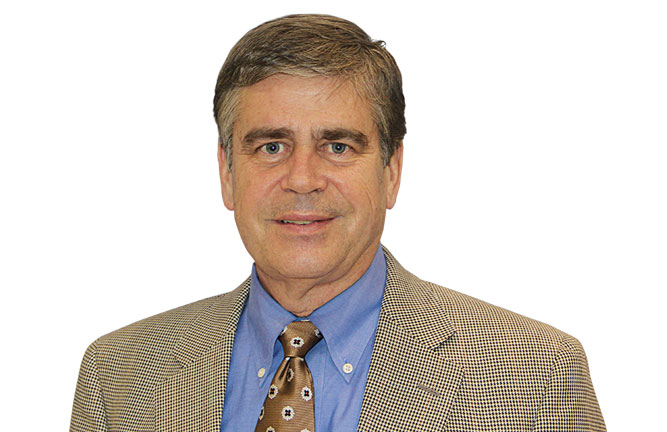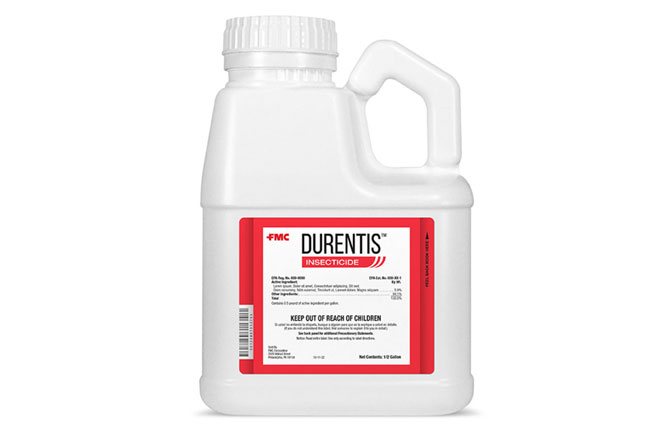Don’t fall behind in annual bluegrass weevil management
The annual bluegrass weevil (ABW) or “Hyperodes weevil” (Listronotus maculicollis, formerly Hyperodes maculicollis) is a severe problem on many golf courses in the northeastern and mid-Atlantic United States and eastern Canada. ABW is intensely managed with insecticides to prevent larval feeding damage to greens/collars, fairways and tees. Problems arise when early season insecticide applications are poorly timed, leading some to make multiple insecticide applications at regular intervals to keep populations in check. Understanding how ABW populations (overwintering adults, first-generation larvae) develop in spring is critical to getting the most out of controls and reducing the need for future applications.
ABW have between one to three generations per year, depending on the region. The first-generation larvae are the offspring of adults that spent the winter in an arrested state in leaf litter in wood lines and tall grasses surrounding the playing surfaces.
Each year, the over-wintering adults walk onto the short-mown areas, where mated females seek hosts (Poa annua and creeping bentgrass turf) to place eggs. If left uncontrolled, females will deposit eggs underneath the plant’s sheath. The larvae develop and feed inside the plant through the first three instars. Older larvae (fourth and fifth instars) become too large for the plant and exit to feed externally on stems and crowns. These stages can cause significant damage in a relatively short time. Damage typically appears during late spring to early summer, making early season lapses in control difficult to outgrow and often extremely apparent for the remainder of the season.
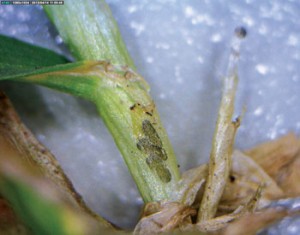
Annual bluegrass weevil females place their eggs between the sheath and the stem of the plant where they are well protected from predators. The eggs change color from yellow (top egg) to black (bottom three) as they become closer to hatching.
Our studies indicate that greater numbers of larvae are present during the first generation and potentially more damaging than following generations (McGraw and Koppenhöfer, 2009a). However, the probability of successfully controlling the first generation is greater than subsequent generations, since summer generations (second and third) will overlap with earlier generations. Sampling turf in the summer often reveals all life stages in the same area. Most of our available chemical insecticides do not kill eggs and pupae and show little promise in controlling young larvae (first to third instars) concealed within the plant. Therefore, even well-timed applications may only provide slight-to-moderate reductions of asynchronous summer populations.
Adulticide or larvicide?
There are two windows of opportunity for controlling first-generation ABW and reducing the need for further intervention: reduce egg laying by overwintering adults (preventive control) or target larvae as they move out of the plant (curative control). Each approach can be successful, but both require precise timing and understanding of ABW development.
Controlling overwintering adults
Traditionally, superintendents have focused on reducing larval damage by eliminating overwintering adults prior to egg laying. They’ve done this by applying a short-residual, broad-spectrum insecticide during the period when adults walk from overwintering sites to short-mown turf areas. This approach has worked effectively for decades, though it’s not without serious consequences. Superintendents who have intensively applied pyrethroids to turf areas for several years have begun to notice a decrease in ABW control. Pyrethroid-resistant ABW were confirmed in southern New England in the mid-2000s (Ramoutar et al. 2009), and we continue to document resistant populations in a much wider geographic area. The development of pyrethroid resistance has brought additional challenges as many ABW populations have become insensitive to non-pyrethroid chemistries as well (cross-resistance).
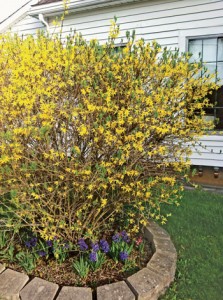
Forsythia has been a useful indicator of ABW adult movement out of overwintering sites and can be useful in timing insecticide applications. The “half green/half gold” stage (when the plant has lost half of its yellow flowers) has been correlated to adult peak densities on the short-mown turf areas and denotes the time when applying adulticides are most effective.
Properly timing the adulticide application has been the biggest hurdle in ABW control, given that ABW adulticides have short residual activity. Ideally, applications are timed to coincide when the majority of adults have emerged from overwintering sites (“adult peak”). We often observe a slow and steady trickle of adults appearing on greens, tees and fairways building up to peak density.
Superintendents who apply before the peak run the risk of their adulticide wearing off before the majority of insects emerge. Insects are cold-blooded organisms and therefore are sensitive to large spring temperature fluctuations. Several warm days may cause significant numbers to advance toward the playing surfaces, and may be followed by days if not weeks of cool weather that cause the adults to remain in suspended animation. Adulticides applied early in the migration period may have little residual activity by the time the remainder of the population arrives.
We investigated the reproductive biology of emerging ABW adults to determine when to time controls based on the threat of egg laying. Adults were sampled weekly from greens, collars and tees from the time adults first emerged from overwintering sites until the end of the first generation. Adults were dissected to determine if females were mated and capable of producing viable eggs. Females were reproductively mature from the start of the emergence period. However, the vast majority of males captured between emergence and peak were reproductively immature and incapable of fertilizing eggs. After peak, males became reproductively mature and able to fertilize eggs. Therefore, waiting to apply the adulticide until all adults have emerged on the short-mown areas will likely lead to greater control (and fewer applications) because adults pose little reproductive threat prior to peak.
We determine when ABW populations are at peak with both passive (e.g. plant indicators, growing degree-days) and active (e.g. soap flushes, checking clippings) techniques. Forsythia bloom has been the most common method of determining adult movement onto playing surfaces. Forsythia spp. full bloom indicates that adults have begun their migration out of overwintering sites, which should initiate scouting with more active means. Forsythia’s “half green/half gold” stage, when the plant has lost half of its yellow flowers, indicates that the adults are at peak density. Weekly sampling for adults with soapy flushes (1-2 ounce liquid dish soap plus 1 gallon water applied over 3-foot x 3-foot areas) during Forsythia blooming events can assist greatly in determining the peak and in refining application timings.
Controlling first-generation larvae
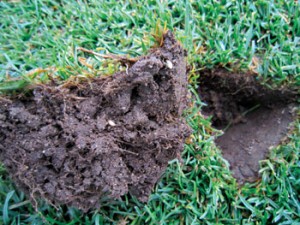
Removing a soil core reveals late-instar larvae (fourth and fifth instars). These stages exit the plant, and therefore may be exposed to contact insecticides. However, older larvae are voracious feeders and capable of causing severe damage if larvicides do not work quickly, are timed poorly or have short-residual activity.
Recently, more superintendents have abandoned preventive management in favor of solely targeting larvae. Many of the larvicides are much “softer” on beneficial insects and have longer residual activity compared to adulticides, and should not require reapplication. Additionally, targeting larvae is more consistent with the tenets of IPM because it involves applying controls where the pest is present and above damage thresholds (30-40 larvae per square foot).
The main deterrents to adopting this approach are the relative higher costs of controls, difficulty in sampling and assessing larval stages, and the potential for underestimating densities. Scouting requires destructively sampling turf, typically by removing cores with a cup cutter or knife and placing the material in a saturated saline solution to extract larvae. Sampling is critical for determining when larval populations are about to move out of the plant and are susceptible to larvicides. However, it’s impractical for most superintendents to obtain detailed estimates of population structure.
Curative approaches require products that work quickly and have lengthy residual activity. It’s critical that controls be applied slightly before larvae appear in the soil because crown feeding can lead to rapid damage. However, it’s equally important for larvicides to persist to control the larvae that have yet to emerge from plants. This is difficult because adults may lay eggs over several weeks, leading to equally long periods when larvae emerge. We caged pairs of ABW adults on Poa annua plugs in the field to determine the potential length of the egg-laying period. Females laid eggs for an average of 5 to 8 weeks, but were capable of laying for up to 14 weeks. Females laid between 60 and 90 eggs on average, with many capable of ovipositing over 100 eggs. Therefore, waiting to control larvae may lead to large populations appearing over several weeks, overlapping life stages, reduced control with single applications and the need for multiple applications to avoid damage.
Combined approach
In the past, ABW was successfully managed with one insecticide application. However, whether because of increased stress placed on the turf by modern cultural practices or because of pesticide insensitivity, many courses require multiple insecticide applications in spring. In areas with high ABW pressure, a sequential application (adulticide followed by larvicide) may be required. A summary of university trials conducted over 20 years has indicated that adulticides lead to greater numerical reductions than larvicides (Koppenhöfer et al. 2012). However, even with a properly timed adulticide against a pyrethroid-susceptible population, the range of control may vary between 60 percent and 90 percent. Therefore, in dense populations, the survivors may be capable of producing enough larvae to cause damage.
The combined approach allows for increasing the safety net in control, though it may be rendered useless by a poorly timed application. It should be stressed that the larvicide application of the combination approach may not be warranted, and should only be applied if sampling reveals that the larval population has exceeded thresholds. Damage appears for a multitude of reasons, including drought stress, traffic and turfgrass species. In a study of mixed annual bluegrass/creeping bentgrass fairways, we found that pure Poa annua plots were 10 to 15 times more susceptible to damage than creeping bentgrass (McGraw and Koppenhöfer 2009b). Courses that are predominately Poa annua may benefit from sequential applications to keep larval densities lower than currently recommended thresholds.
What to take home
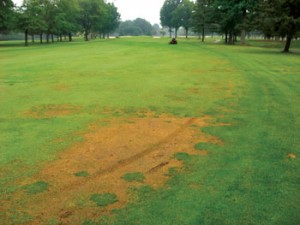
First-generation larval feeding damage may often be severe on the edges of rough-short mown borders. Damage expression is influenced by many factors, including larval density, turfgrass species and plant stress.
There are strong arguments for all three management philosophies. Before formulating your ABW management plan, please realize that 100-percent control of a population is not feasible. Even the best products applied at the best possible times won’t control every insect. Successful control should be defined as maintaining weevil densities that do not cause visible damage, with the fewest applications possible.
Ideally, different approaches are needed for different areas, based on past history of damage, stress and turfgrass species. In areas where some damage may be tolerated, a single preventive or curative application is enough when scouting has determined that weevils are present in damaging numbers. No two ABW populations are identical, and because of the stresses imposed on the turf and chemical use history, different populations will not respond the same to similar controls. Taking the time to scout populations and understand the biological basis for timing products will lead to higher levels of control with fewer wasted applications.
Photos courtesy of: Ben McGraw






